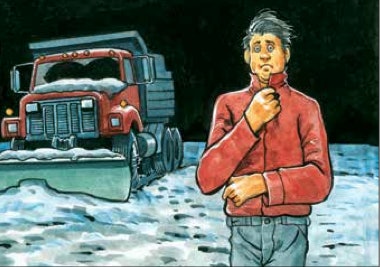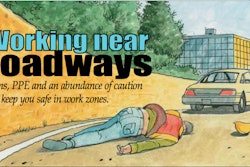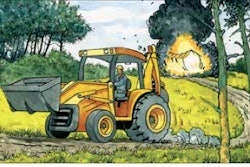
The accident: Anticipating a warm night in a plow-truck cab, a landscape company employee showed up for work at 8 p.m. wearing sneakers, jeans, a thin shirt and light jacket. He was plowing the parking lot of a large mall when the truck broke down at 1 a.m. All businesses in or near the mall were closed. The man walked three-quarters of a mile in a snowstorm before finding an open gas station. He was treated at a hospital for frostbite on his ears, fingers and toes.
What the expert says: Always bring cold-weather gear to work in winter, cautions Rick Rollo, vice president of operations for landscape management firm KEI in Oak Creek, Wisconsin. Without it, situations can become life-threatening in minutes. For instance, exposed skin can freeze in the time it takes to walk five blocks when the wind-chill temperature is 10 to 15 degrees below zero.
Wind and moisture are factors just as important as temperature – and can make hypothermia possible even on an above-freezing day. “Wet clothing and wind are our biggest fears,” Rollo says. “People don’t realize how fast these two things suck the heat out of your body.”
Keeping your head, hands and feet warm should be your primary concern. Up to 40 percent of body heat can be lost through the head, according to OSHA. Rollo says Balaclavas and bomber hats made of wool or a knit material with a wind-proof outer shell are the most popular forms of headgear with KEI employees. Wear insulated gloves designed for cold weather. If there’s a chance your hands will get wet or be exposed to chemicals (you’re removing ice and snow, for instance), wear insulated, water-proof, chemical-resistant, rubber gloves. Your employer should provide these gloves. Keep in mind: OSHA doesn’t require your company to provide “ordinary weather-related gear,” and if you lose employer-provided PPE, you have to replace it. Waterproof, insulated boots will keep mois- ture out, but if you don’t wear the right socks they’ll also keep sweat in. Polyurethane socks wick away moisture; wear them next to your skin. Put wool socks, which absorb moisture, over them. Here are some more tips for staying safe in cold weather:
• Wear three clothing layers: an inner layer of cotton or synthetic weave; a middle layer of wool or synthetic fabric; and an outer layer of nylon or Gore-Tex.
• Change into dry clothing/gear immediately if any part of your body gets wet. Keep a plastic bag with extra gloves, hat and socks in the truck you drive to jobsites.
• Recognize the symptoms of cold stress – shivering, blue lips, fatigue, drowsiness or euphoria. If you experience shivering or blue lips, go to a warm place, drink something warm and move your arms and legs. Call 911 if symptoms progress further.
• If skin on your fingers, hands, toes, feet, ears or nose tingles, turns waxy-white, hard or numb, seek medical attention. You could have frostbite. Don’t try to warm the skin yourself; you could cause more damage.
• Wear eye protection. Blowing snow and salt can irritate your eyes and impair your vision, leading to accidents.










